
1.
Kalasin
Kalasin is a province and province capital city in Isan (Khorat Plateau). The landscapes are mostly plains, in the northeast also hills, smaller rivers and some lakes, namely Laem Pao Reservoir, a large dammed lake created in the 1960s for irrigation purposes.
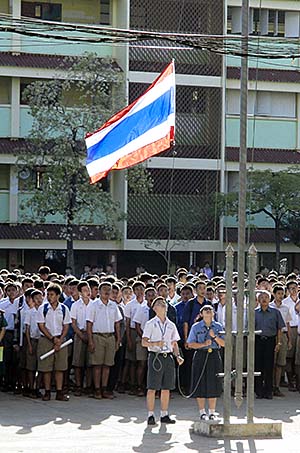
Morning flag ceremony in Kalasinpittayasan school. It comes with official announcements and the national anthem. Image by Asienreisender, 11/2015
The border to the neighbouring province Sakon Nakhon is formed by a hill chain, the Phu Phan range, partially declared a national park.
Kalasin is a remoter place, not placed along main routes and therefore it gives a much quieter impression than some other Isan cities with a similar number of inhabitants (what is around 35,000, comparable e.g. to Buriram). Nevertheless is the town itself as much a naked concret monster as any other usual Thai city of our time.
The economy is, typically for Isan, based on agriculture, mostly sticky rice, vegetables, livestock and cash crops as casava and sugar cane. There is much trade of course and an industrial sector.
The people of Kalasin are certainly mostly of Laotian roots.
There are two lakes in Karasin, who get their water from Laem Pao River; it's a large one at the northern edge of town, close to the city's prison, and a smaller one, at the western edge, called Kud Nam Kin Lake.
Worth to be mentioned is the Kalasin Museum on the grounds of the city hall. There are models of traditional local dwellings, items of local crafts and many original tools etc. displayed in several rooms over two levels. Seems that few visitors go here, and I got a personal guidance. Entrance and the friendly guide were both for free.
Kud Nam Kin Park and Lake
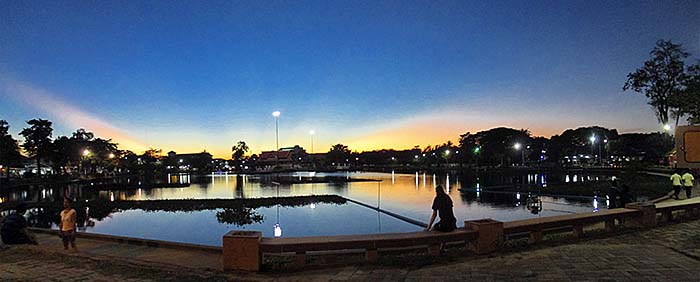
Short behind, means west of Kalasin's bus station, is a very nice little lake with a recreation park at the western side. In the evening many local people come here to do jogging around the lake or to use the sports instrument who are free for public use, including those in the small gymnasium there. The lake's shore is seamed with small restaurants.
Also the annual Loi Krathong, the 'floating light festival', is celebrated here in November.
The lake is getting it's water from Laem Pao River who flows out of the dammed lake with the same name, a tributary of Nam Chi. Image by Asienreisender, 11/2015
Very remarkable is an earth historical site at the foot and slopes of Phu Kum Khao, where fossils of dinosaurs from the time about 120 million years ago have been found. It's the largest dinosaur site in Thailand.
At the site a new museum has been built. This museum is a large modern building with aircon separated into eight zones at the foot of Phu Kum Khao. It's surrounded by a greater garden and opened in 2008. It has named by and after princess Sirindhorn of the Chakri dynasty of Thailand.
Dinosaur (Sirindhorn) Museum Kalasin
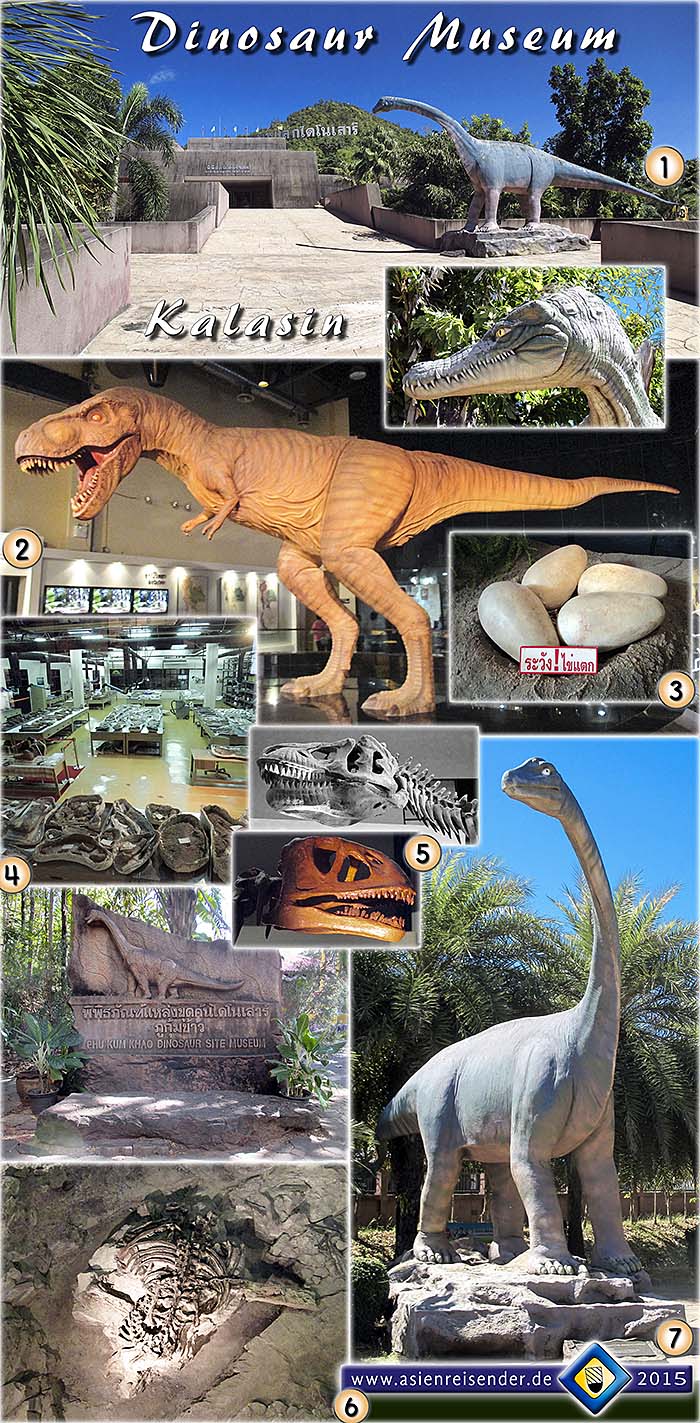
In the museum's garden are many dinosaur sculptures placed. At the slopes, about 200m from the main museum, is an excarvation site open for the public which shows original dinosaur remains in the ground (6). More than 700 dinobones have been found here.
In the main museum (1) the whole evolvement of the universe is sketched, beginning with the explanation of the big bang theory and the development of the solar system with it's nine planets (in fact now ten, recently a hithero unknown tenth planet has been discovered).
The next zone explains and illustrates the geological development on the early earth, followed by the biological evolution. In the focus of the museum are of course the dinosaurs, of who a number are displayed as images, fossils, sculptures and shown in films. In the center of the museum, under a large glass dome, are several dinosaur skeletons placed, some as small as a smaller dog, others as big as a bus. All these skeletons are artificially made, probably after the model of real ones; but they are too perfect to be real and one sees also that the material they are made from can not be real bone.
In the last zone are skulls from different hominids between the age of 4 million years via a homo erectus from Sangiran in Java (see also: 'The Java Man'), a Neanderthal man (homo neanderthalensis) and finally a modern cro-magnon (homo sapiens) man from Germany (see the photocomposition below).
The written information at the different items are all both in Thai and English; the films are all in Thai only. All I missed was more detailed information and a brochure for those who like to dig a bit deeper. Entrance fees for foreigners 100 Baht, for Thais 40 Baht.
By the way: In the background of the main museum's building is Phu Kum Khao (the mountain) to see (1).
The grand star of the museum is apparently a Siamotyrannus isanensis (2), a relative and maybe ancestor of the famous Tyranosaurus rex who lived in North America. Siamotyrannus isanensis lived about 130 million years ago. This specimen had a length of 6.5m and a sculpture of it dominates the museum's foyer.
Another prominent dinosaur of the site, a sauropod, is Phuwiangosaurus sirindhornae (7), who measured 15m to 20m in length and lived about 130 million years ago. Remains of this animal were found first in the neighbouring province Khon Kaen, but the most complete skeleton of it was found later at Phu Kum Khao in Kalasin Province. At the excavation site one can see part of it's skeleton (6).
The two dinosaur skulls (5) are part of the collection of skeletons in the museum's center. The dino eggs are at least 20cm in length and weight certainly several hundred grammes.
Images and photocomposition by Asienreisender, 11/2015
Hominid Evolution
Skulls in Evolvement
The 'Toumai' skull of a Sahelanthropus tchadensis was found in 2001 in the Djurab Dessert in northern Chad. It's about six to seven million years old. The brain size is estimated of 340ccm3 to 360ccm3. This very early hominid did not stand and walk upright.
The Australopithecus africanus was found in 1924 and called the 'Taung Child' after the name of a village nearby the finding place in South Africa. It's the skull of a three or four years old child which was maybe killed by a bird of prey. It's brain size is given with 405ccm3. These hominides probably walked already upright on two legs.
The Homo erectus javanicus has been discovered in 1969 at Sangiran, Java (see also: 'The Java Man'). It's about a million years old and had a brain volume of a liter.
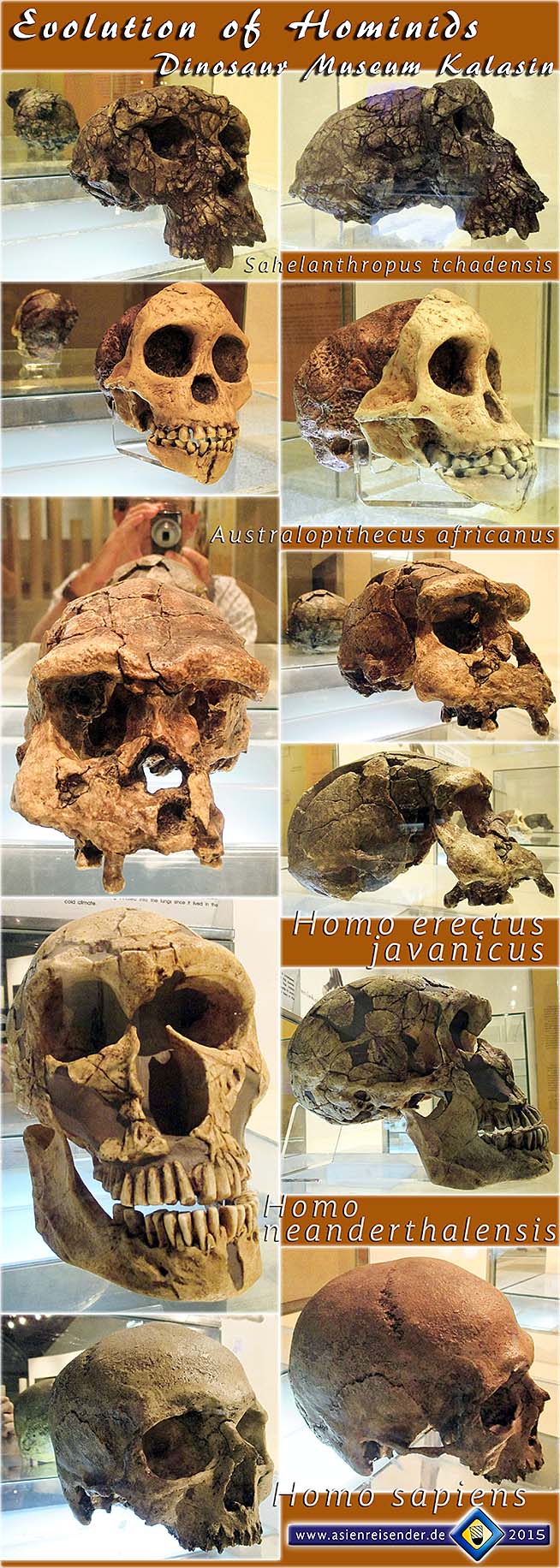
The Neanderthal Man is about 50,000 years old and has been found in La Ferracie, France, in 1909. This hominid had a brain volume of 1,750 ccm3 and was larger than modern man. The big nostrils were to warm the breath before inhalating them, because Homo neanderthalensis was adapted to the cold, European climate of the last ice age.
Cro-Magnon is already a 'modern' man with a brain volume of about 1,400ccm3. This skull was found in 1998 in the Rhine Valley near Mainz, Germany.
Images and photocomposition by Asienreisender, 11/2015
2.
The History of Kalasin
Archaeological traces proof the settlements of a tribal people called Lawa who lived in the province in the time around 400 CE.
There is also much evidence for the presence of the Dvaravati Culture, namely the necropolis of Mueang Fa Daet Song Yang, which dates 1,000 years back. There were also a number of Dvaravati border stones found in the province, some of them are placed in local temples like Wat Nuea in Kalasin.
The first modern town in the province was founded in 1793 CE.
The province of Kalasin came into existence in October 1947. Before, it was a district of Maha Sarakham Province.
Mueang Fadaet Songyang and Phratat Yakhu

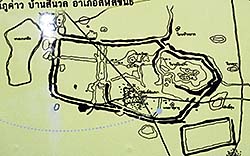
A map of Mueang Fadaet in Kalasin Museum. The black line is the contemporary overland road. The chedi stands where the blue dot is. Image by Asienreisender, 11/2015
The site of Mueang Fadaet Songyang is a historical settlement. There is a long history of the place who was inhabited already in the time of early sedentariness, of which old pottery findings give witness. In medieval times the place became a fortified town and repeatedly expanded. In it's late phase it was of the considerable size of 171 hectare, surrounded by a still existing moat and a city wall. A large water reservoir lied outside the walled town, which still exists. This phase is dated into the late 1st millenium and was part of the Dvaravati Culture.
At the site nowadays is a tall chedi and the remains of three other chedis in a straight line. Of the other chedis are only small heaps of bricks remaining.
The main chedi is surrounded by a number of Dvaravati borderstones. Some of them show buddhist motives, those of others are barely or no more recognizable.
Close to the chedi are a few smaller buildings, some of them offices, the largest is a small museum with some more border stones. One shows part of the old city wall with a gate in the center and, as it could be seen, with some warriors as defenders overlooking the wall.
Images and photocomposition by Asienreisender, 11/2015